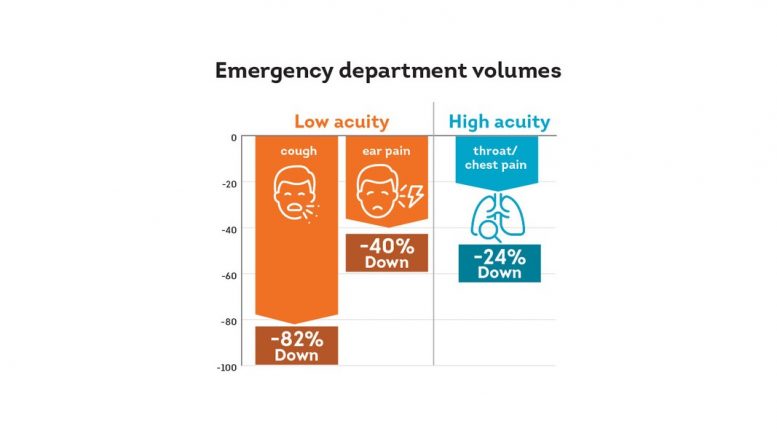TransUnion Healthcare research finds new trends that could lead to cost reductions for patients and providers
Hospital visit volumes continued to slowly recover at the end of June with emergency department visits down only 25% compared to pre-COVID-19 volumes. The latest findings from TransUnion Healthcare (NYSE: TRU) also indicated patients with high-acuity medical issues (i.e. chest pain) are returning to emergency departments at a faster pace than those with low-acuity concerns (i.e. cough and ear pain), which are likely being treated in alternate settings.
 This potential change in medical treatment settings could point to healthcare cost reductions for providers, patients and payers as emergency department care is typically more expensive than what is offered at a medical clinic or via telehealth options. As potential shifts take place in healthcare settings, a new book titled, “Healthcare Evolution: Helping Providers Get Paid in an Era of Uncertainty,” and authored by Jonathan Wiik, principal of healthcare strategy at TransUnion Healthcare, was officially released today. The book addresses healthcare affordability problems – including the cost challenges of emergency department overutilization – and what strategies can be implemented to alleviate payment pressures.
This potential change in medical treatment settings could point to healthcare cost reductions for providers, patients and payers as emergency department care is typically more expensive than what is offered at a medical clinic or via telehealth options. As potential shifts take place in healthcare settings, a new book titled, “Healthcare Evolution: Helping Providers Get Paid in an Era of Uncertainty,” and authored by Jonathan Wiik, principal of healthcare strategy at TransUnion Healthcare, was officially released today. The book addresses healthcare affordability problems – including the cost challenges of emergency department overutilization – and what strategies can be implemented to alleviate payment pressures.
The updated analysis of 500+ hospitals across the United States observed patient volumes between March 1-7 and June 21-27. When looking at specific treatment settings, TransUnion Healthcare’s analysis found outpatient visit volumes are down 7% during the week of June 21-27, recovering 88% of volume lost in the time since April 5-11 (when visit volumes reached their lows). During this same time period, emergency department visits recovered 51% and are down 25%; inpatient volumes show a 75% return while down 8% compared to pre-COVID-19 volumes.*
“TransUnion Healthcare is closely monitoring healthcare utilization – particularly as specific regions see a resurgence in COVID-19 cases and possible subsequent deferrals of elective procedures,” said David Wojczynski, President of TransUnion Healthcare. “We want to equip providers with insights that can help them best mitigate financial challenges and maximize care delivery amidst this uncertainty. Jonathan’s latest book addresses many of these challenges while offering strategies that can be applied by healthcare providers to alleviate payment burdens on patients and also build trust with them.”
TransUnion Healthcare’s analysis also found key differences when comparing adult and children visit volumes across treatment settings between March 1-7 and June 21-27:
- Emergency Department: Within the emergency department setting, adult visit volumes are returning more quickly than children visit volumes – only down 16% during the week of June 21-27. Comparatively, visit volumes for children remain significantly below pre-COVID-19 volumes and are down 59% in the same time period.
- Outpatient: Adult patients lead the path to recovery for outpatient visit volumes as well. During the week of June 21-27, adult visit volumes are down 5% whereas children visit volumes were down 34%.
- Inpatient: For inpatient treatment settings during the week of June 21-27, the latest analysis found adult visit volumes are recovering slightly slower than children volumes, with adults down 9% and children down 6% compared to pre-COVID-19 volumes.
“It’s clear that many adults are beginning to return for regularly scheduled appointments, though we suspect many are electing to hold off bringing their children back to these healthcare settings. Interestingly, due to the complexity and challenges with price transparency within our current healthcare system, patients aren’t necessarily aware of the differing cost consequences when considering where to obtain care,” said Wiik. “However, our latest analysis reveals patients with low-acuity diagnoses have avoided emergency department settings amidst COVID-19. If this trend continues, it presents an opportunity for providers to engage patients early to help non–emergent patient populations navigate the most efficient and effective care setting. This has the potential to reduce healthcare costs for all stakeholders.”
When looking at patient admitting diagnoses within emergency department settings between March 1-7 and June 14-20, TransUnion Healthcare’s research found adult visit volumes for less acute diagnoses have returned at a slower pace than more acute diagnoses. In fact, visit volumes for coughs and ear pain – typically considered low-acuity diagnoses – remain down 82% and 40%, respectively. Higher-acuity diagnoses such as throat/chest pain have seen a greater return in volumes, down 24% compared to pre-COVID-19 volumes.
Broader challenges with healthcare delivery and affordability
Should this trend extend beyond COVID-19, the impacts of this shift could positively affect the healthcare system overall. Overutilization of the emergency department has been a consistent issue for the U.S. healthcare system, creating care delivery and affordability challenges for all stakeholders, representing almost $382 billion annually in wasted spend per a report from UnitedHealth Group.
Wiik’s book highlights how this challenge is further complicated by the Emergency Medical Treatment and Labor Act (EMTALA), which requires anyone presenting at an emergency department to be stabilized regardless of their ability to pay or health insurance coverage. An unintended consequence is that many patients receive treatment at one of the most expensive sites of care in the healthcare system, often without a choice to go somewhere else after they arrived, even in cases where their illness may not require it.
“Healthcare costs remain high, and the industry has yet to agree upon a holistic, long-term strategy to curb them,” said Wiik. “The book offers effective strategies to all stakeholders, particularly healthcare providers who want to protect their earned revenue and empower frictionless, positive patient experiences.”
The book also explores how patients, providers and payers can alleviate payment friction they all face and how each stakeholder can be more effective in aligning their payment strategies for positive financial outcomes. For providers specifically, several industry best-in-class processes and tools are shared that address common pitfalls in patient financial clearance, underpayments and denials, consumerism and transparency.
Wiik is presenting a webinar as part of the Healthcare Financial Management Association (HFMA) Virtual Annual Conference on July 15 at 2:45 pm CT titled “Healthcare Evolution: Revenue Protection in an Era of Uncertainty.” Healthcare professionals that are interested in attending can register for the webinar here. Following the presentation, the webinar will be available here. Please visit www.transunion.com/jonathan-wiik or Amazon.com to order your copy of “Healthcare Evolution: Helping Providers Get Paid in an Era of Uncertainty.”
*TransUnion Healthcare defines pre-COVID-19 volumes as the average weekly visits measured during the first 8 full weeks of the year, from the weeks of January 5-11 through February 23-29.

